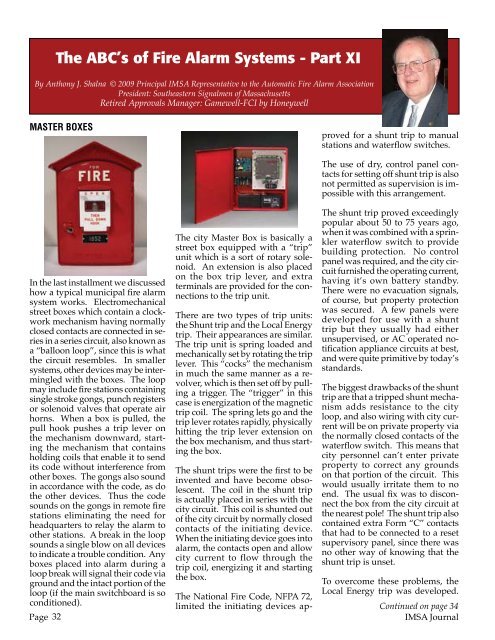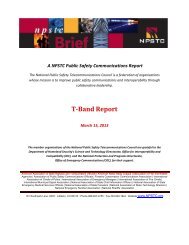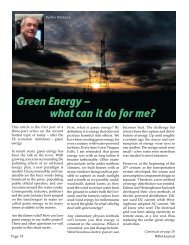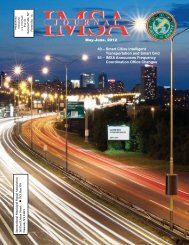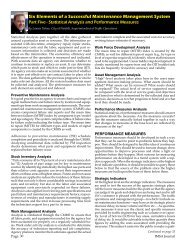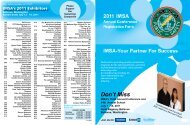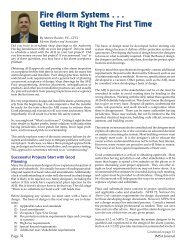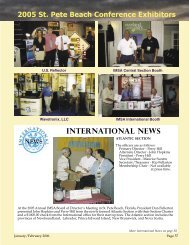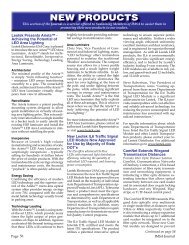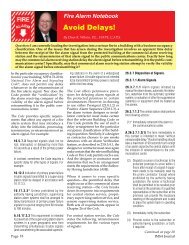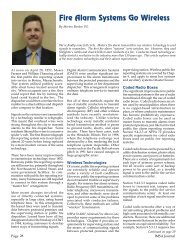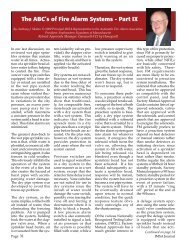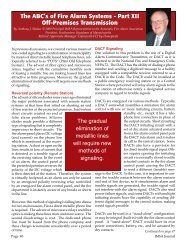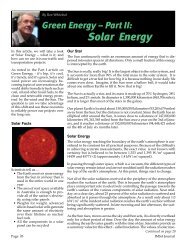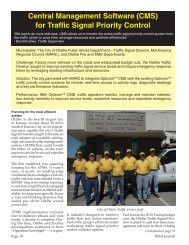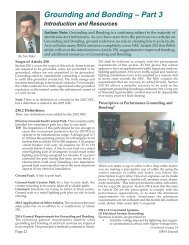The ABC's of Fire Alarm Systems - Part XI - IMSA
The ABC's of Fire Alarm Systems - Part XI - IMSA
The ABC's of Fire Alarm Systems - Part XI - IMSA
Create successful ePaper yourself
Turn your PDF publications into a flip-book with our unique Google optimized e-Paper software.
<strong>The</strong> ABC’s <strong>of</strong> <strong>Fire</strong> <strong>Alarm</strong> <strong>Systems</strong> - <strong>Part</strong> <strong>XI</strong><br />
By Anthony J. Shalna © 2009 Principal <strong>IMSA</strong> Representative to the Automatic <strong>Fire</strong> <strong>Alarm</strong> Association<br />
President: Southeastern Signalmen <strong>of</strong> Massachusetts<br />
Retired Approvals Manager: Gamewell-FCI by Honeywell<br />
MASTER BOXES<br />
proved for a shunt trip to manual<br />
stations and waterflow switches.<br />
<strong>The</strong> use <strong>of</strong> dry, control panel contacts<br />
for setting <strong>of</strong>f shunt trip is also<br />
not permitted as supervision is impossible<br />
with this arrangement.<br />
In the last installment we discussed<br />
how a typical municipal fire alarm<br />
system works. Electromechanical<br />
street boxes which contain a clockwork<br />
mechanism having normally<br />
closed contacts are connected in series<br />
in a series circuit, also known as<br />
a “balloon loop”, since this is what<br />
the circuit resembles. In smaller<br />
systems, other devices may be intermingled<br />
with the boxes. <strong>The</strong> loop<br />
may include fire stations containing<br />
single stroke gongs, punch registers<br />
or solenoid valves that operate air<br />
horns. When a box is pulled, the<br />
pull hook pushes a trip lever on<br />
the mechanism downward, starting<br />
the mechanism that contains<br />
holding coils that enable it to send<br />
its code without interference from<br />
other boxes. <strong>The</strong> gongs also sound<br />
in accordance with the code, as do<br />
the other devices. Thus the code<br />
sounds on the gongs in remote fire<br />
stations eliminating the need for<br />
headquarters to relay the alarm to<br />
other stations. A break in the loop<br />
sounds a single blow on all devices<br />
to indicate a trouble condition. Any<br />
boxes placed into alarm during a<br />
loop break will signal their code via<br />
ground and the intact portion <strong>of</strong> the<br />
loop (if the main switchboard is so<br />
conditioned).<br />
<strong>The</strong> city Master Box is basically a<br />
street box equipped with a “trip”<br />
unit which is a sort <strong>of</strong> rotary solenoid.<br />
An extension is also placed<br />
on the box trip lever, and extra<br />
terminals are provided for the connections<br />
to the trip unit.<br />
<strong>The</strong>re are two types <strong>of</strong> trip units:<br />
the Shunt trip and the Local Energy<br />
trip. <strong>The</strong>ir appearances are similar.<br />
<strong>The</strong> trip unit is spring loaded and<br />
mechanically set by rotating the trip<br />
lever. This “cocks” the mechanism<br />
in much the same manner as a revolver,<br />
which is then set <strong>of</strong>f by pulling<br />
a trigger. <strong>The</strong> “trigger” in this<br />
case is energization <strong>of</strong> the magnetic<br />
trip coil. <strong>The</strong> spring lets go and the<br />
trip lever rotates rapidly, physically<br />
hitting the trip lever extension on<br />
the box mechanism, and thus starting<br />
the box.<br />
<strong>The</strong> shunt trips were the first to be<br />
invented and have become obsolescent.<br />
<strong>The</strong> coil in the shunt trip<br />
is actually placed in series with the<br />
city circuit. This coil is shunted out<br />
<strong>of</strong> the city circuit by normally closed<br />
contacts <strong>of</strong> the initiating device.<br />
When the initiating device goes into<br />
alarm, the contacts open and allow<br />
city current to flow through the<br />
trip coil, energizing it and starting<br />
the box.<br />
<strong>The</strong> National <strong>Fire</strong> Code, NFPA 72,<br />
limited the initiating devices ap-<br />
<strong>The</strong> shunt trip proved exceedingly<br />
popular about 0 to 7 years ago,<br />
when it was combined with a sprinkler<br />
waterflow switch to provide<br />
building protection. No control<br />
panel was required, and the city circuit<br />
furnished the operating current,<br />
having it’s own battery standby.<br />
<strong>The</strong>re were no evacuation signals,<br />
<strong>of</strong> course, but property protection<br />
was secured. A few panels were<br />
developed for use with a shunt<br />
trip but they usually had either<br />
unsupervised, or AC operated notification<br />
appliance circuits at best,<br />
and were quite primitive by today’s<br />
standards.<br />
<strong>The</strong> biggest drawbacks <strong>of</strong> the shunt<br />
trip are that a tripped shunt mechanism<br />
adds resistance to the city<br />
loop, and also wiring with city current<br />
will be on private property via<br />
the normally closed contacts <strong>of</strong> the<br />
waterflow switch. This means that<br />
city personnel can’t enter private<br />
property to correct any grounds<br />
on that portion <strong>of</strong> the circuit. This<br />
would usually irritate them to no<br />
end. <strong>The</strong> usual fix was to disconnect<br />
the box from the city circuit at<br />
the nearest pole! <strong>The</strong> shunt trip also<br />
contained extra Form “C” contacts<br />
that had to be connected to a reset<br />
supervisory panel, since there was<br />
no other way <strong>of</strong> knowing that the<br />
shunt trip is unset.<br />
To overcome these problems, the<br />
Local Energy trip was developed.<br />
Continued on page 34<br />
Page 2<br />
<strong>IMSA</strong> Journal
<strong>The</strong> ABC’s <strong>of</strong> <strong>Fire</strong> <strong>Alarm</strong> <strong>Systems</strong> – <strong>Part</strong> IX . . . Continued from page 32<br />
This trip unit also contains a coil,<br />
but the coil is connected to a dedicated,<br />
supervised city box circuit <strong>of</strong><br />
a fire alarm control panel listed for<br />
municipal connection. <strong>The</strong> trip coil<br />
acts as an end <strong>of</strong> line device, and<br />
only one trip unit may be connected<br />
to this circuit. <strong>The</strong> LE trip derives its<br />
name from the use <strong>of</strong> “local” energy<br />
from the protected premises control<br />
panel. When the panel goes into<br />
alarm, current is applied to the Local<br />
Energy trip unit, allowing it to rotate<br />
and set <strong>of</strong>f the box mechanism. One<br />
very important thing to remember is<br />
that there is no electrical connection<br />
between a LE trip and the city box<br />
mechanism or circuit. <strong>The</strong> connection<br />
is purely mechanical, as the LE<br />
trip lever spins and physically hits<br />
the box trip lever extension. Reset<br />
supervision is accomplished by<br />
means <strong>of</strong> a set <strong>of</strong> normally closed<br />
contacts in the trip unit in series with<br />
the coil. <strong>The</strong>se contacts are nicknamed<br />
“suicide contacts” and open<br />
when the unit is tripped. <strong>The</strong>y close<br />
when the trip is physically reset.<br />
Hence, when the unit is tripped, it<br />
will create a trouble condition on the<br />
city box circuit until reset. An interesting<br />
fact is that the LE trip unit is<br />
activated by applying current. <strong>The</strong><br />
unit is set to trip at approximately<br />
.2 0 milliamperes, voltage not being<br />
relevant. Hence, it can be tripped by<br />
a 12 or 2 VDC control panel, and is<br />
not involved in battery calculations,<br />
since the suicide contacts immediately<br />
disconnect it from the circuit.<br />
At one time, the trip was also rated<br />
for higher voltage AC use, requiring<br />
1/ amp. <strong>of</strong> AC current.<br />
ELECTRONIC MASTER BOXES<br />
Recently, thanks to the latest electronic<br />
technology, an electronic<br />
master box has been introduced.<br />
This unit connects in place <strong>of</strong> the<br />
old electromechanical unit, <strong>of</strong>ten<br />
in a similar housing. It contains<br />
electronically controlled municipal<br />
signaling contacts and features twowire<br />
initiating circuits with end <strong>of</strong><br />
line resistor that are activated by<br />
dry contacts on the control panel<br />
that short circuit the EOL resistor.<br />
<strong>The</strong> advantage <strong>of</strong> this type <strong>of</strong> box is<br />
that it can send multiple coded signals<br />
that may be used for signaling<br />
trouble, supervisory or zoned alarm<br />
signals, as desired. Its power is obtained<br />
from the protected premises<br />
control panel. <strong>The</strong> current electronic<br />
master box is Listed for use at a great<br />
range <strong>of</strong> temperature and humidity<br />
extremes.<br />
RADIO MASTER BOXES<br />
Keltron Radio Box<br />
SigComm Radio Box<br />
Radio master boxes are somewhat<br />
different from street boxes, since<br />
they are located where plenty <strong>of</strong><br />
power is available. <strong>The</strong>se master<br />
boxes might be located in ordinary<br />
looking sheet metal enclosures and<br />
need not be located outside the<br />
building, since they are not wired<br />
to a city circuit. <strong>The</strong>y somewhat<br />
resemble a conventional fire alarm<br />
control panel except the notification<br />
appliance circuits are replaced by a<br />
radio transmitter and antenna. This<br />
master box could contain any number<br />
<strong>of</strong> Class A or B initiating circuits,<br />
depending on the manufacturer,<br />
and, like the electronic master box,<br />
is capable <strong>of</strong> transmitting multiple<br />
coded signals.<br />
Connections to a radio master box<br />
are similar to those in the electronic<br />
master box. <strong>Alarm</strong>s are created by<br />
shorting the initiating circuit(s) by<br />
means <strong>of</strong> dry contacts in associated<br />
fire alarm control panels or directly<br />
from detectors or stations. <strong>The</strong> radio<br />
master boxes can also send different<br />
zone signals to the central console,<br />
giving the fire department valuable<br />
advance information regarding high<br />
rise fires, special hazards, special occupancies,<br />
etc. Trouble and Supervisory<br />
signals can also be transmitted.<br />
A central <strong>of</strong>fice for radio signaling is<br />
the same as for radio street boxes.<br />
Redundant receiving consoles are<br />
used for “fail-safe” reasons. Test<br />
signals are transmitted periodically<br />
for supervision. A missing test signal<br />
results in a “box missing” signal being<br />
displayed on the console.<br />
With the recent economy problems,<br />
some fire departments are preferring<br />
multiple or zoned alarm signals.<br />
Ordinarily a large response is made<br />
to an alarm <strong>of</strong> fire, <strong>of</strong>ten with ladder<br />
trucks, etc. only to find a small fire<br />
that activated a single heat detector.<br />
Meanwhile resources are limited<br />
in the event <strong>of</strong> a simultaneous or<br />
subsequent alarm that may require<br />
a maximum response. Thus activation<br />
<strong>of</strong> a single device such as a<br />
detector or pull station will allow<br />
the fire dept. to provide a minimum<br />
response and not tie up scarce resources<br />
that might be required to<br />
respond to other alarms. Multiple<br />
zones or devices in alarm would<br />
indicate a large, expanding fire allowing<br />
the fire department adequate<br />
reserves to provide a maximum<br />
response.<br />
Page <strong>IMSA</strong> Journal


